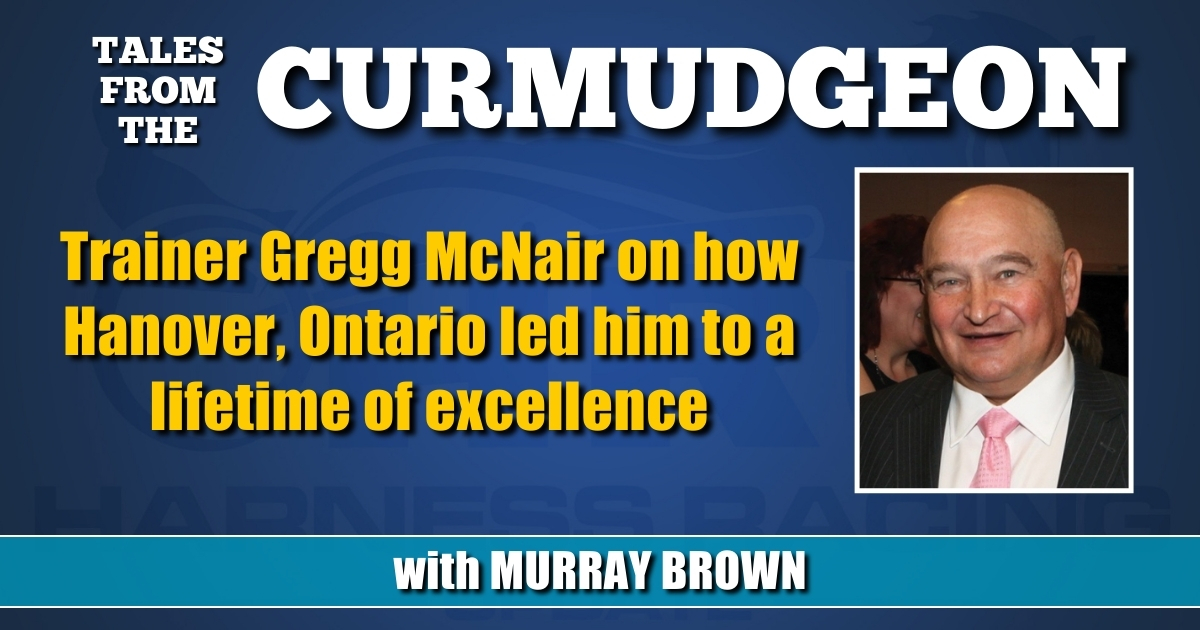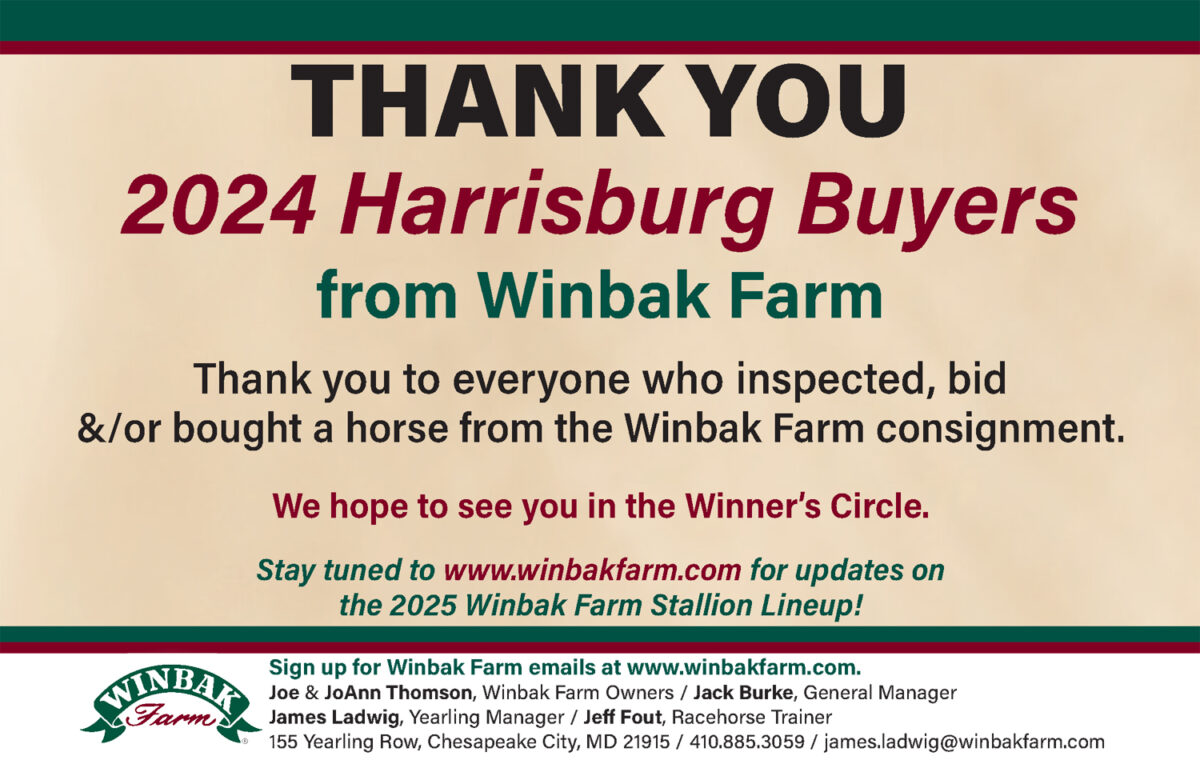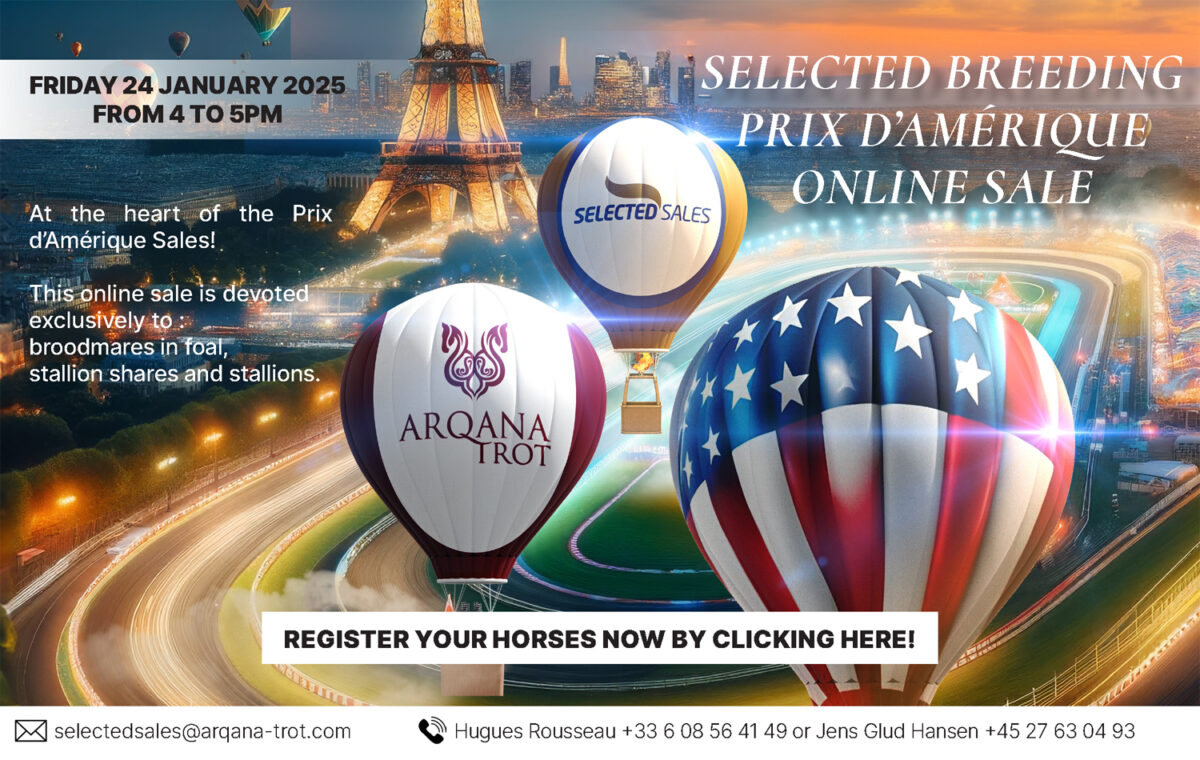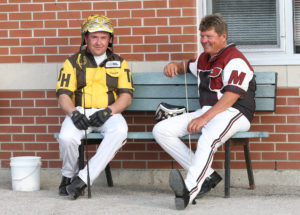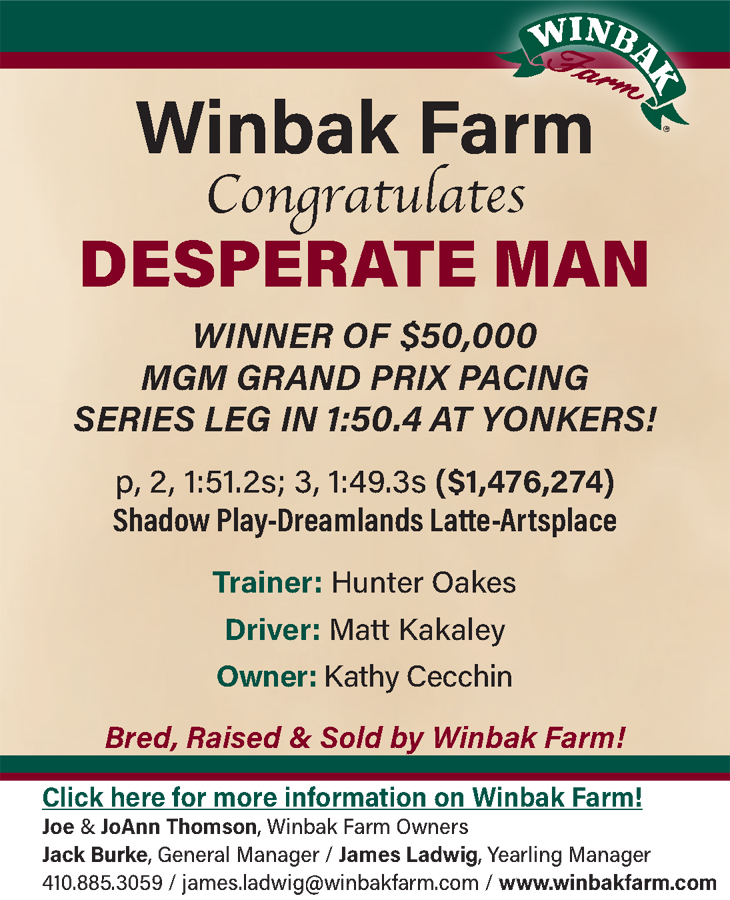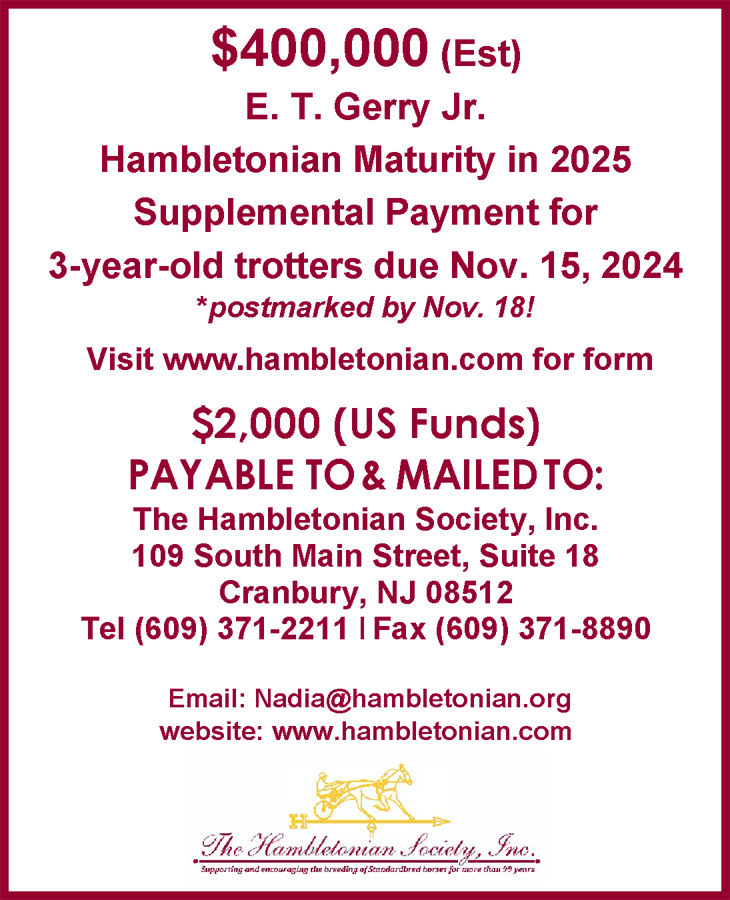Trainer Gregg McNair on how Hanover, Ontario led him to a lifetime of excellence
by Murray Brown
“Were you born into the business?” this intrepid reporter asked of Gregg McNair. “Not exactly,” was the response.
“My dad was into livestock. He occasionally bought a broodmare. That kind of began my interest in harness horses. Probably the biggest factor in my getting involved in the sport was where we lived. The little town of Hanover, Ontario was a great breeding ground of harness horsemen. I suppose the most prominent ones were Canadian Horse Racing Hall of Famer and multiple O’Brien-winning horseman Bud Fritz and his family. I started my career working for him. From there, I worked with Bill Lambertus, an excellent horseman, both as a driver and trainer, before setting out on my own.
“The first horse that I remember my dad owning was a nice trotter by the name of Speed Galore. He was just a nice solid trotter that Bud Fritz trained for him.
“I took the first stable that I assembled to Windsor Raceway, where I stayed for around 10 years. Racing there was a great opportunity for me. It was a great place to race horses. Many top horsemen began, or furthered their careers there. Among them were John Campbell, Bob and Doug McIntosh, Greg Wright, Bill Gale and Ray Remmen.
“My stable at that time was almost totally composed of overnight horses and claimers. Windsor presented a great opportunity for me. The track raced in winter. People from my hometown area would send horses to me to hopefully raise some income at that time of year. My job was to classify them correctly and have them earn some needed purse money and/or get them claimed. It never much bothered me when a horse in my stable was claimed. One of the first important lessons I learned was that if you put one in a claimer, expect that it could be claimed. I think that it was especially the case with me, because I tried to be as realistic as I could possibly be when putting them in for a tag. I suppose that was something I inherited from my dad’s livestock background.
“The turning point in my transition from being mostly a claiming horse trainer to one who specialized in training and developing young horses was with the best horse I had in my formative years, an excellent pacer by the name of Lusty Leader.
“He was in to race at Lexington. That was the first time I had been there. I was totally enchanted by the atmosphere. Of course, most of the racing involved young horses — some of which were superstars and others who were destined to become that. I ended up going to the sales and bought a couple of yearlings. I decided that was the direction in which I wanted to go.”
Let’s begin with Windsor. I understand that’s where you began your long association with Keith Waples.
“When Keith would spend his winters training in Florida, his first stop on his way north would be at Windsor Raceway. I first became well acquainted with him there. He would stay there for a month or more and rented a room from me in a home that I had. What an honor that was. As most people know, Keith could be a man of few words. But like the man in those old E F Hutton commercials would say, ‘When he spoke, you listened’ and if you were paying attention, you learned.
“We became friends. I was stabled at Keith’s and his son’s Gordie’s farm from 1993-2003. I’ve been honored to train horses for him for close to 15 years. I would say we’ve been fairly successful. He occasionally still rode behind some of the horses until fairly recently.
“One year Keith mentioned that I might want to try racing in Montreal. If I was interested, he would be willing to make a few phone calls to help me get started. He called Mike MacCormac who was head of racing at the time. I don’t believe I’ve ever been treated better in all my years in the sport. As for the racing end of it, I didn’t do all that well, but it was a terrific experience. There were still a very good group of horsemen racing there at the time. Those that come to mind are Rick Zeron, Henri Filion, Jacques Hebert, Benoit Cote and Mario and Ben Bailleargeon.”
You have your own training center in South Florida. How did that come about?
“I suppose it was a combination of the cold, snowy winters in Ontario and the transition from being primarily a stable that concentrated on overnight racehorses to one that focused on young horses destined to hopefully become stakes horses. We’ve always maintained a group of older racehorses that we raced year long. We’d leave them up north to race and hopefully earn some money while we developed the younger stock down south.
“I had thought of training the youngsters down south for some time. It became a choice between going to an existing training center and paying rent or one that I owned myself and one at which I could call all the shots. I decided on the latter.
“The Henry family had their own training center in Okeechobee about 40 miles west of Fort Pierce which is about 50 miles north of Palm Beach. It’s a fairly secluded area and is more countrified than some of the larger training centers in Florida. I bought 50 acres close by the Henrys’ place, first intending to build a mile track. It turned out that to do so I’d have to have the house and stable inside the track. That didn’t suit me, so I decided to go with what I feel is an ideally suited half-mile track. We’ve now been down there 10 years and it has worked out well.”
You have a well-earned reputation of being very considerate of your owners. You treat them well and are completely above board with them.
“That’s something that I’m pretty proud of. If I have a failing in that regard, it might be that I sometimes don’t communicate well enough or that I can be difficult to get in touch with. But I try my best. I’ve had horses with Ian Fleming since 1983. My oldest owner, Ken Sommer, just passed away a year ago at the age of 98. I can’t exactly recall when he first sent me horses to train, but it was some time ago. It might not always be for unselfish reasons. I own at least a piece of most of the horses in my stable, so being perfectly honest with the owners means that I am being so with myself, as well.”
You’ve assembled a great group of loyal owners through the years. What is it about lawyers for whom you train? Off the top of my head, you train for Jim Avritt, Richard Arnold and the Horner brothers Clay and Scott, all of them well known and successful attorneys.
“The two things that they all have in common is that they are all brilliant and they all care deeply about their horses. I’ve been fortunate enough to have varying degrees of success with them all.
“Jim Avritt is the one who has been with me the longest and I suppose he is the one with which we have had the most success. The best horse that I had for him was the world champion filly Precocious Beauty who earned more than $800,000 and if that is possible, as great a race filly as she was, she might even be better as a broodmare. Her first colt being the world champion and 2020 Horse of the Year Tall Dark Stranger. Those who know Jim know how dedicated he is to his horses. He is very hands on in every phase of their development. Chances are almost certain that if you were to visit his beautiful boutique farm in Lebanon, Kentucky, it would be Jim himself who leads out the yearlings for you to look at. He knows everything about the dams and all the foals that they have produced. If, after you’ve bought one of his yearlings, you might think you are done with him, you would be mistaken. You will receive regular phone calls as to their progress and well wishes for their future endeavors.
“In addition to being a renowned attorney, Richard Arnold is also well known as being one of the foremost cattle breeders in America. He hasn’t reached that status yet in the horse business, but he is a smart person and I wouldn’t bet against that happening. I bought Bettor Sun from him at the 2019 Lexington sale for $30,000. He called me and asked if I would let him in as a partner. I said, ‘sure.’ All we did thus far is win the 2020 edition of the Battle of Waterloo with him. I can’t tell you much about him as a lawyer other than he is considered to be an outstanding one. But in terms of overall knowledge on a vast variety of subjects, I’ve never met a person more interesting.
“The two Horner brothers, Clay and Scott, are somewhat different from each other. Scott is very hands on. In winter, he spends a lot of time with his horses. He rides behind the horses on a regular basis. He wants to know about the health of his horses. No detail is too small. I speak with Clay regularly, but in terms of what is being done with his horses, unless something is of great importance, he prefers to leave it all up to me.”
How has this COVID year affected you?
“As with just about everybody else, it hasn’t been good. But I’ve been one of the lucky ones compared with others. There have been two big reasons for this. Firstly the makeup of my stable, most of the off days were in the winter and spring when the majority of our horses weren’t racing anyway. Secondly, even when most of the folks in Canada were completely shut down, we were in a position where we could send our racing stock to the States and earn some money with them. It wasn’t ideal or what we were used to, but we were a whole lot luckier than most of those racing up here.”
This conversation wouldn’t be close to complete unless we spoke about the apple of your eye, your son Doug. He is already close to, if not already, a superstar driver.
“Before we get to Dougie, I need to mention my wife Susie and my other son Scott and my daughter Amy. We are a close knit family and all of them, plus the dedicated and long-time staff of loyal employees, have all played a significant role in any of the success we have had.
“Now to Doug. If loving the sport and dedication to it were the sole credential of becoming a great driver, then Dougie would have been considered a sure thing. From an age where he first became aware of the horses, I couldn’t, even if I had wanted to, keep him out of the stable or from going along with me to wherever I was racing. He was as the saying goes ‘born in a feed bucket.’ There were so many questions to ask and he wanted to know the answers to all of them. He always wanted to become a driver. He never stopped watching races, nor did he ever stop asking questions mostly from Bill Gale and Jim McClure.
“Fortunately for Doug, they would always answer. He started out driving with his contemporary Scott Zeron at the small Ontario fairs. Because of their fathers, they likely got a better chance than do most youngsters starting out. But there have been other sons of famous horsemen who got the same chances and just were not good enough.
“Doug drove his first race at the Dundalk Fair at the age of 12. His horse might have been older than him.
“In 2008, his first year of driving competitively he won the Battle of Waterloo with our homebred Trail Boss. Since then he has won a host of big races.
“In 2017, he received an O’Brien Award as Canada’s Driver of the Year. Among other achievements, he was the youngest driver to win 1,000 races and the youngest to drive the winners of over a million dollars in a single year.”
Here’s when this writer knew that Gregg McNair was a lot better than an average horseman. It was the fall of 2012. Hanover Shoe Farms had a consignment at the Lexington sales. Among the yearlings consigned was a Muscle Hill filly named Chivaree Hanover. The filly was from the second crop by her sire and the first foal from her well-bred dam. Then, as now, the Muscle Hills were an extra hot item. Yet, this filly brought only $12,000 in a select session. To look at her, there was nothing wrong. She stood fine and had a pretty decent video. Except that she was a witch. If you wanted to, you could substitute the “W” in witch with a “B” and you wouldn’t be wrong. She was downright nasty. If you gave her the chance, she would try to hurt you.
We told everybody who came to look at her that she could be dangerous — to be careful around her. Gregg was walking by the consignment and happened to see the filly being shown. She looked alright, which she was, except for her disposition. He was the ‘lucky’ buyer on her. Shortly after he signed for her, I saw Gregg and asked him if her knew about the filly’s bad behavior. He did not. But he said for that price, he’d try her anyway.
In my mind’s eye I could see her breaking jog carts and never getting broke.
Imagine my surprise when early in her 2-year-old season I saw her in to race. Not only race, but win stakes races. She took a record of 1.56.3 at 2 and lowered it to 1.54.4 at 3. She earned $185,147 at 2 and 3 including several stakes.
When Chivaree Hanover was 2, I saw Gregg at Lexington. I asked him about the filly. He said that her disposition hadn’t changed at all. She was still a nasty witch. The next morning I went to see her at Gregg’s stable. Same old Chivaree, rear end ready to let go and ears pinned. I thought that if he could do as well with her as he did, when just about everybody else thought she couldn’t even be broke to a jog cart, then he had to be a very special horseman.
Have a question or comment for The Curmudgeon?
Reach him by email at: [email protected].







